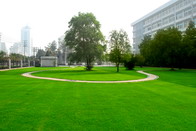|
|
| Key Laboratory of Dynamic Geodesy (KLDG) |
TEXT SIZE:A A A |
| |
Key Laboratory of Dynamic Geodesy (KLDG), established in November 1989, is the unit engaged in
dynamic geodesy in Chinese Academy of Sciences(CAS). The KLDG uses advanced terrestrial and
spatial geodetic methods such as satellite laser ranging(SLR), GPS and gravimetry to measure the
changes in the Earth’s dynamic system and study their mechanism. The geodetic measurements
and studies provide theoretical bases and fundamental materials for researches on environment
evolution, resource exploration, global changes and space sciences. Main research subjects of the
KLDG are
Local crustal movements and global rotation of the earth;
Earth’s interior structure and Geospheres’interactions;
Geodetic applications in engineering, national defense, environment and disaster monitoring.
Academic Committee of the KLDG is composed of 14 famous Chinese specialists(including 4
Chinese academicians) in the field of Earth sciences. The staffs of the laboratory in clued 27 members,
most of them having a PhD degree. The KLDG has the qualifications to award PhD degrees and Master
degrees in geodesy and in solid geophysics. A post-doctorial station of science and technology of survey
was set up in the laboratory in 1999. The laboratory also maintains a comprehensive observation station,
in which there are a series of geodetic instruments providing technical support and first-hand observa-
tional data for the geodetic researches.
Openness, intercourse. Cooperation and competition are the administrative principle of the KLDG. Thanks
to the leading action of the Academic Committee and the significant efforts of the whole staff. The KLDG
has found good developments in scientific research, academic intercourse and graduate education in
recent years. The KLDG has been active in national and international scientific cooperation. Since 1989,
the KLDG has established international cooperation with more than 20 foreign geodetic institutions of
Asia, Europe and America, and realized the exchange and share of the observational data.
The developing objectives of KLDG will be engaged in (i) providing technical and scientific supports for
military surveying. Disaster monitoring and national engineering from the geodesy side; (ii) developing the
studies on local crustal movements, global rotation of the earth and on the Earth’s interior structure and
Geospheres’interactions; (iii) enforcing the innovation and assembly of dynamic geodetic technologies
and (iv) training prospective geodetic researchers. The KLDG has been played and will play an important
role in national security, social maintainable development and earth science research. |
 |
|
| |
| |
|
|
|
|
|
Regional and Global Movement
of the Earth |
Structure of the Earth’s interior
and geospheres interactions |
|
|
|
|
Mass distribution and transport in Earth system |
| | |
 |
 |
|
|

